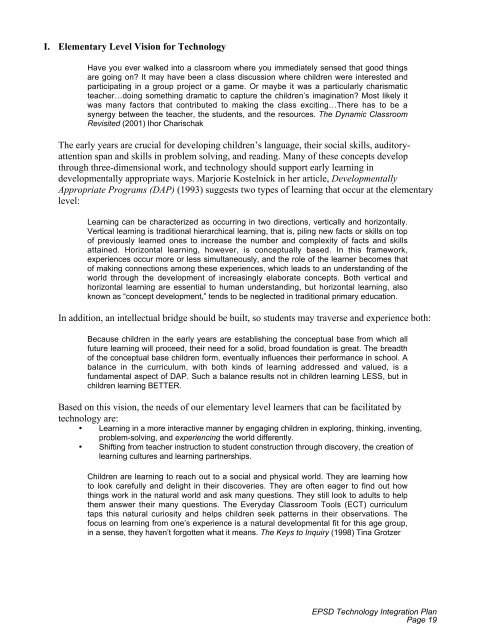EPSDtechintplan2004
EPSDtechintplan2004
EPSDtechintplan2004
You also want an ePaper? Increase the reach of your titles
YUMPU automatically turns print PDFs into web optimized ePapers that Google loves.
I. Elementary Level Vision for Technology<br />
Have you ever walked into a classroom where you immediately sensed that good things<br />
are going on? It may have been a class discussion where children were interested and<br />
participating in a group project or a game. Or maybe it was a particularly charismatic<br />
teacher…doing something dramatic to capture the children’s imagination? Most likely it<br />
was many factors that contributed to making the class exciting…There has to be a<br />
synergy between the teacher, the students, and the resources. The Dynamic Classroom<br />
Revisited (2001) Ihor Charischak<br />
The early years are crucial for developing children’s language, their social skills, auditoryattention<br />
span and skills in problem solving, and reading. Many of these concepts develop<br />
through three-dimensional work, and technology should support early learning in<br />
developmentally appropriate ways. Marjorie Kostelnick in her article, Developmentally<br />
Appropriate Programs (DAP) (1993) suggests two types of learning that occur at the elementary<br />
level:<br />
Learning can be characterized as occurring in two directions, vertically and horizontally.<br />
Vertical learning is traditional hierarchical learning, that is, piling new facts or skills on top<br />
of previously learned ones to increase the number and complexity of facts and skills<br />
attained. Horizontal learning, however, is conceptually based. In this framework,<br />
experiences occur more or less simultaneously, and the role of the learner becomes that<br />
of making connections among these experiences, which leads to an understanding of the<br />
world through the development of increasingly elaborate concepts. Both vertical and<br />
horizontal learning are essential to human understanding, but horizontal learning, also<br />
known as “concept development,” tends to be neglected in traditional primary education.<br />
In addition, an intellectual bridge should be built, so students may traverse and experience both:<br />
Because children in the early years are establishing the conceptual base from which all<br />
future learning will proceed, their need for a solid, broad foundation is great. The breadth<br />
of the conceptual base children form, eventually influences their performance in school. A<br />
balance in the curriculum, with both kinds of learning addressed and valued, is a<br />
fundamental aspect of DAP. Such a balance results not in children learning LESS, but in<br />
children learning BETTER.<br />
Based on this vision, the needs of our elementary level learners that can be facilitated by<br />
technology are:<br />
• Learning in a more interactive manner by engaging children in exploring, thinking, inventing,<br />
problem-solving, and experiencing the world differently.<br />
• Shifting from teacher instruction to student construction through discovery, the creation of<br />
learning cultures and learning partnerships.<br />
Children are learning to reach out to a social and physical world. They are learning how<br />
to look carefully and delight in their discoveries. They are often eager to find out how<br />
things work in the natural world and ask many questions. They still look to adults to help<br />
them answer their many questions. The Everyday Classroom Tools (ECT) curriculum<br />
taps this natural curiosity and helps children seek patterns in their observations. The<br />
focus on learning from one’s experience is a natural developmental fit for this age group,<br />
in a sense, they haven’t forgotten what it means. The Keys to Inquiry (1998) Tina Grotzer<br />
EPSD Technology Integration Plan<br />
Page 19


